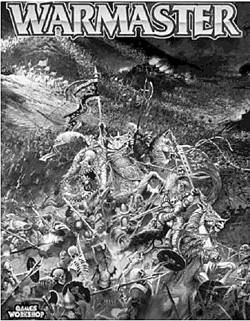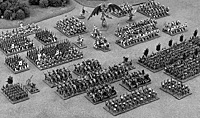
The rules come in a full colour 160-page book retailing for AUS$34.95. Unlike previous GW products it is intended that Warmaster as released will be complete and not be subject to continual upgrades, revisions, add-ons etc. In the book there is everything you need: the rules themselves (about half the book) painting guides, how to make terrain guide, army lists, optional rules, campaign and siege rules (very handy for any period), battle scenarios, and an appendix with a rules summary. All extremely comprehensive and very good value for money.
The figures as mentioned above are 10mm and mounted in strips. They come in packs of 6 strips of infantry (6 figures per strip) including one command strip; 6 strips of two figures each for cavalry. The Empire personality packs I was provided with for this review included 4 lovely fully armoured Knights, an infantry command strip, a strip of wizards (with assorted magical tomes), and chaps having a pint or two around a table (as you do). Packs of basic line infantry were priced at AUS$11.95 each, and the army lists indicated that the average unit is about 3 strips. The Empire Halberdiers, for example, come in 6 strips (including cmd.) per blister, 2 strips per stand, 3 stands per unit.
According to David Taylor of the Sydney GW Studio, a 1000 point army will cost in the range of AUS$150 while a 2000 pointer will probably cost $250-300. This is another reason why this could well be huge. The packs also include bases for the figures.
Released in April this year, Warmaster ® is the latest of a long range of innovative and well developed products from Games Workshop. This company is perhaps unique in the wargaming industry for its reach, commercial success and worldwide popularity. A s a historical gaming purist of 20 years I have had long held GW in contempt for its blatant commercialism, exorbitant prices, and cynical (albeit clever and effective) use of rule/product developments to get their target markets (or their parents) to fork out more money.
But having said that I had to admit that the production values of their products, their organisation, and the turn out of fans for the competitions impressed me. In terms of colour, enjoyment and imagination they are unparalleled. The impact they have had in terms of modelling from their excellent paint range, for instance, should also not be underestimated. The conventional wisdom and grumbling around the camp fires of the grognards was that on one hand GW siphoned off new blood from the more “sensible and orthodox” realms of wargaming, but eventually the teenage masses would “grow-up” and turn to the true faith of historical gaming.
For the most part the latter hasn’t been the case, but there has been an evolution within GW to provide a more intellectually challenging game for their existing fans. There is of course Warhammer Ancient Battles®, which has its aficionados, but in the face of the rampar ts of the DB rule series it has failed to make much of an impression here in Australia. Warmaster however, could well be the Next Big Thing and the cross-over point from Fantasy to Historical (and vice versa).
Written by Rick Priestly, Stephen Hess, and Alessio Cavatore, Warmaster is essentially a complete rule system and figure range scaled for an army level wargame. It is a Medieval/Renaissance game with fantasy elements incorporated, the basic unit being a regiment with provision for creating and fighting in Brigade size formations. All the usual GW suspects are here: Armies of Dwarfs, High Elves, Undead, Orcs, Chaos, and Empire (human with a distinct 30 Years War look and feel about them), complete with Artillery, Heroes, Wizards, Magic, Sieges, Orders etc. The figures are about 10mm, and of the standard of sculpting you have come to expect from GW, quite excellent and imaginative.
If GW were attempting to achieve legitimacy in the eyes of non-fantasy gamers this would be the vehicle to do it. The rules are simple, complete and the game is approached as a “straight” historical battle, the magic etc, is more flavour than centrepiece of the system.

The first armies released in April are High Elves and Undead, with armies released in pairs about every month thereafter. Apparently Dwarves and Empire are the next cabs off the rank in May. The types of figures/units in each army will most likely be familiar to GW players, and so will their characteristics. Cute things like the Dwarf Gyrocopter, Wolf Riders, Giants, Flagellants (that is the figures - not the players!), Giant Eagles, Skull Chukkas etc, are all here. Just very small and very cute. Other standard units include Halberdiers (Empire); Skeletons (Undead); Warriors (Chaos); Black Orcs (obvious!); Archers (Elves) Handgunners (Dwarves). Each army also includes cavalry, chariots, artillery, Generals, Heroes and Wizards, and particular magic items/spells, which can be treated as a form of Electronic Warfare and Counter-Measures.
Naturally all units/characters etc, cost points to purchase when constructing an army list. Generals, Wizards, Hero’s are important for fundamentals like issuing orders to a particular number of units per turn and adding bonuses in combat situations.
As a digression, fans of Lord of the Rings will not doubt be aware, the production of the three movies are well underway in New Zealand. When the first comes out next year I can see these rules perfect for fighting the battles in front on Minas Tirith for instance. The siege rules (including towers and catapults) are excellent and very straightforward and there are rules covering ship combat so the Corsairs of Umbar could well make an appearance.
In regard to the rules themselves, everything is spelled out and illustrated in true GW style. The introduction to the rules makes the point that these rules are very different in premise from Warhammer. This is because this is a rule system emphasising Command and Control and coordinating your unit’s assets to best advantage. For players with Ancient gaming experience I think you could apply fundamental tactics here quite effectively. The sequence of play has three basic phases: Command which include issues orders to troops and moving into contact (the former not always a certain thing); Shooting be it cross bow, artillery, or firearms; and Combat where melees are resolved. Units are rated in three ways essentially: Attacks they can make (number of dice rolled in a combat phase per stand in a unit), Hits they can take (number of hits they take before a stand is removed), and Armour class (which negates hits received). I shan’t delve into the minutiae of the mechanisms, but they are logical, and whilst Warhammer is a game of chance, winning at Warmaster will come as result of some tactical savvy. Aspects such Initiative, unit morale, formations, pursuits, and the effects of terrain are all included.
Another level to use the units is at the Brigade level where up to four units of any type are joined together. They can be issued an order to act as one, instead of the usual process of the General rolling for each unit one at a time. Movement rates are essentially 20cm for infantry, 30cm for Cavalry and Chariots, 100cm for flying units, 60cm for Characters which means that the area size for playing this game can be quite small. The combat system runs essentially like this: the stands that are in contact get to roll for the attacks, with appropriate modifiers for factors such as fighting a flank. For troops in open you need a 4 or higher on a 1d6 to get a hit (troops in fortifications are naturally harder to hit ). If the unit has armour for every hit on that unit it rolls again to save against the hit.
So if a unit gets four hits but saves two on its armour throw, the balance is two hits. Combat is simultaneous. Units that took more hits than given lose the combat and retreat a distance determined by how many hits it took, the victorious unit has several options ranging from pursuit to falling back depending on what the player wishes to do.
The combat system lends itself to non-fantasy combat of course. It could easily apply to Ancient to Renaissance without too much difficulty and knowing too well how gamers like to tinker with rules, I’m sure it will. Take away the magic etc, and you have a very straightforward set of rules suitable for most occasions.
In closing, this product is highly recommended on several grounds. I looked hard for faults in the product (no pictures of Orcs in the book, but that was due to the fact that at the time of printing they hadn’t been finished) but I drew a blank. The relative affordability, the completeness of the system, the high standard of the figures and the ease of play make this a very attractive game. While I’m sure few of us can really justify more figures in our collections, the uniqueness of this range make them very enticing indeed. Once a skeptic, this reviewer has been won over and I think it will be interesting to see the implications of this new product and what cross-over will take place with gamers of all persuasions. Score : 9/10.
Phillip is the author of the Napoleonic rules Élan and a regular contributor to this magazine. He was invited to write this review by Games Workshop Australia.
Back to Table of Contents -- Kriegspieler #9
To Kriegspieler List of Issues
To MagWeb Master Magazine List
© Copyright 2000 by Kriegspieler Publications.
This article appears in MagWeb (Magazine Web) on the Internet World Wide Web.
Other military history articles and gaming articles are available at http://www.magweb.com